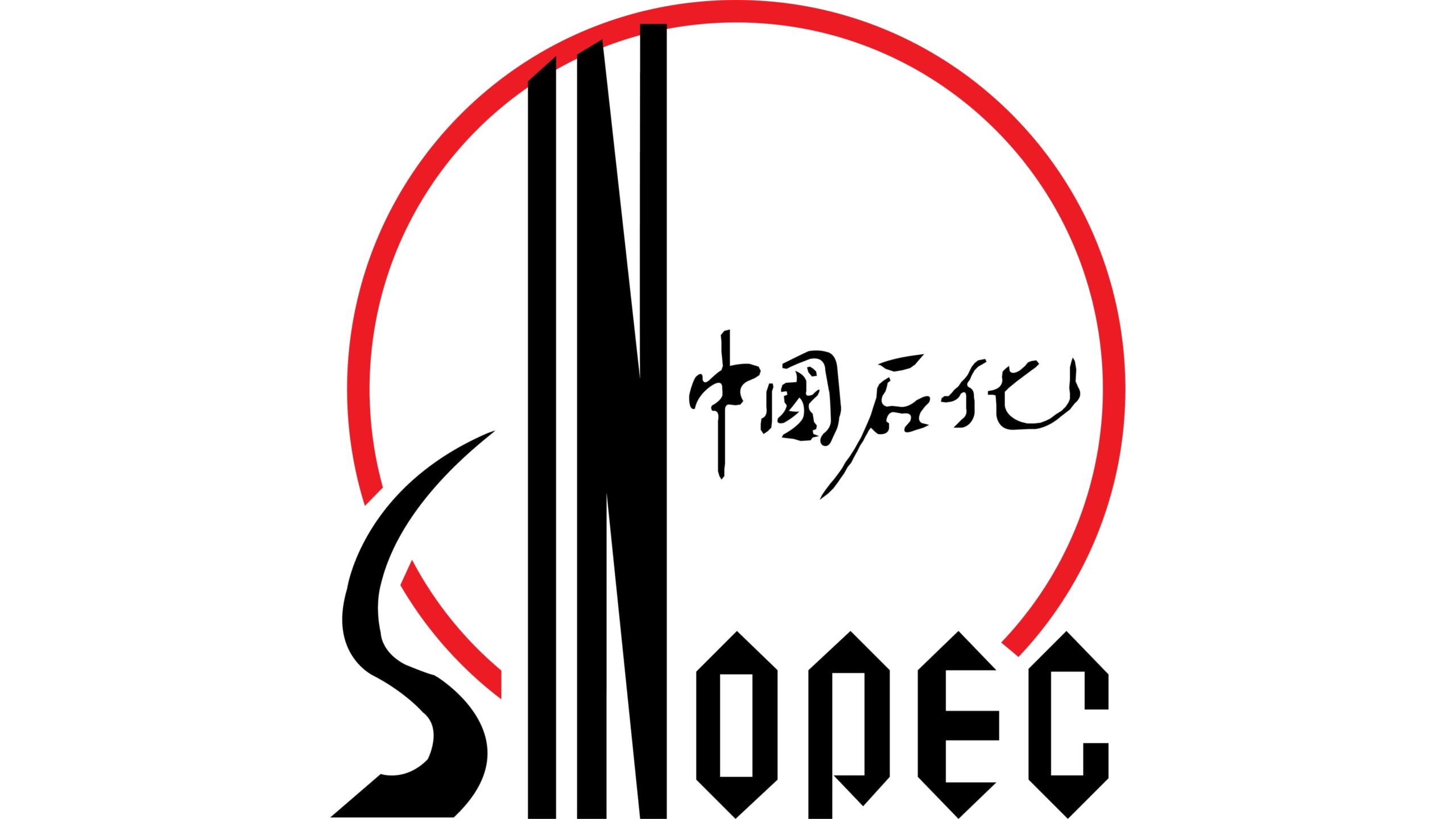Global Milled Carbon Fiber Market: By Fiber Type, By Application, By End Use Industry, By Region & Segmental Insights Trends and Forecast, 2024 – 2034
- Industry: Chemicals & Materials
- Report ID: TNR-110-1179
- Number of Pages: 420
- Table/Charts : Yes
- June, 2024
- Base Year : 2024
- No. of Companies : 10+
- No. of Countries : 29
- Views : 10136
- Covid Impact Covered: Yes
- War Impact Covered: Yes
- Formats : PDF, Excel, PPT
Milled carbon fiber is a versatile reinforcement material composed of short, finely ground carbon fibres. These fibres, typically ranging in length from 50 to 200 microns, are produced by milling larger carbon fiber structures. The resulting material retains the inherent properties of carbon fiber, such as high strength-to-weight ratio, excellent thermal and electrical conductivity, and superior resistance to chemicals and environmental degradation. Milled carbon fiber is widely used as a reinforcement in various composite materials, enhancing the mechanical properties of polymers, resins, and concrete.
Its fine particulate form allows for uniform distribution within the host material, resulting in improved tensile strength, stiffness, and durability. Industries such as automotive, aerospace, construction, and sporting goods benefit from its ability to produce lightweight, high-performance components. Additionally, its application in advanced manufacturing processes like 3D printing and additive manufacturing highlights its critical role in developing innovative, efficient, and sustainable solutions across diverse sectors.
The demand for milled carbon fiber is primarily driven by its exceptional mechanical properties and versatility across multiple industries. In the automotive and aerospace sectors, the material’s high strength-to-weight ratio is crucial for reducing vehicle weight, enhancing fuel efficiency, and meeting stringent emissions standards. The construction industry benefits from its use in reinforcing concrete, significantly improving structural durability and resilience.
Additionally, the growing adoption of advanced manufacturing techniques, such as 3D printing and additive manufacturing, leverages milled carbon fiber for producing complex, high-performance parts. The renewable energy sector, particularly wind turbine manufacturing, also drives demand due to the material’s ability to enhance blade efficiency and longevity. These diverse applications underscore the expanding role of milled carbon fiber in modern engineering and sustainability efforts.
In terms of revenue, the global milled carbon fiber market was worth US$ 192.5 Mn in 2023, anticipated to witness CAGR of 10.2% during 2024 – 2034.
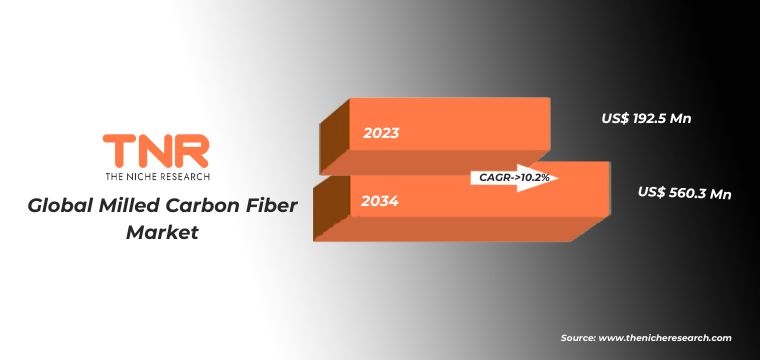
Global Milled Carbon Fiber Market Dynamics
Increasing Demand in Automotive and Aerospace Industries: The automotive and aerospace sectors are major consumers of milled carbon fiber due to its lightweight and high-strength properties. In automotive applications, it helps improve fuel efficiency and reduce emissions, while in aerospace, it enhances the performance and durability of aircraft components.
Advancements in Manufacturing Technologies: Technological advancements in manufacturing processes, such as additive manufacturing and 3D printing, have expanded the applications of milled carbon fiber. These technologies enable the production of complex, high-performance parts that benefit from the material’s superior mechanical properties.
Growth in Renewable Energy Sector: The renewable energy sector, particularly wind energy, increasingly uses milled carbon fiber to reinforce turbine blades. This improves blade efficiency and durability, contributing to the sector’s expansion and the material’s market growth.
Regulatory and Environmental Pressures: Stringent environmental regulations and the push for sustainability drive the adoption of milled carbon fiber. Industries seek to comply with emissions standards and reduce their carbon footprint by using lightweight, durable materials.
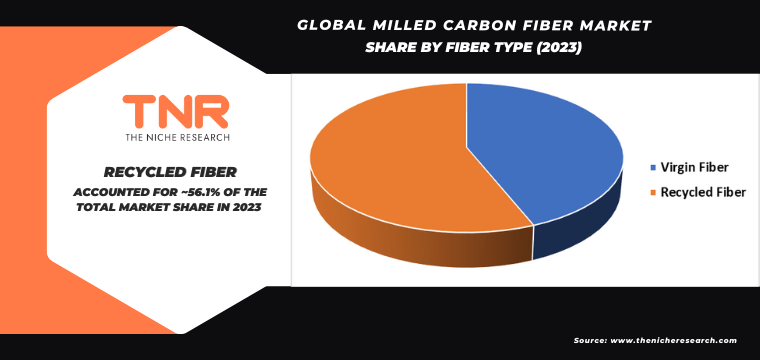
By Application, Reinforcement Segment is Projected as the Fastest Growing Segment in the Global Milled Carbon Fiber Market in 2023.
The demand for milled carbon fiber in reinforcement applications is primarily driven by the need for enhanced material properties in various industries. Milled carbon fiber, with its excellent strength-to-weight ratio and high stiffness, is increasingly used to reinforce polymers, concretes, and other composite materials. In the construction industry, incorporating milled carbon fiber into concrete significantly improves its tensile strength and durability, making structures more resilient to stress and environmental factors.
In the automotive and aerospace sectors, milled carbon fiber-reinforced polymers are essential for producing lightweight, high-performance components that enhance fuel efficiency and structural integrity. Additionally, the sporting goods industry utilizes these reinforcements to create high-strength, lightweight equipment that improves athletic performance. The ongoing advancements in material science and the push for more durable, efficient, and sustainable products across various sectors continue to drive the demand for milled carbon fiber reinforcements, highlighting their critical role in modern manufacturing and engineering solutions.
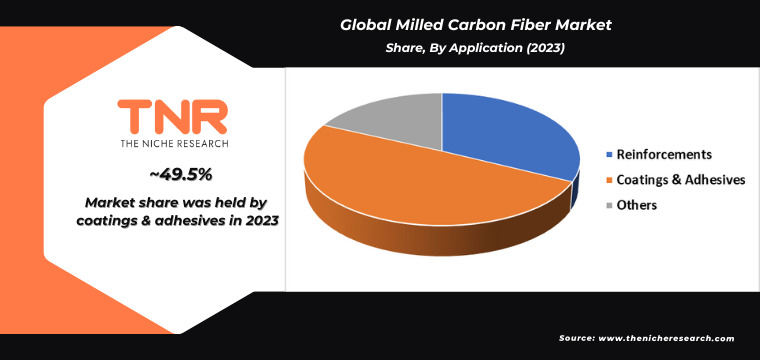
By End Use industry, Automotive Industry Segment had the Highest Share in the Global Milled Carbon Fiber Market in 2023.
The automotive industry’s demand for milled carbon fiber is driven by the critical need to enhance fuel efficiency and meet stringent emissions regulations. As governments worldwide, particularly in Europe, impose stricter CO2 emission standards, automakers are under pressure to innovate and reduce vehicle weight without compromising performance or safety. Milled carbon fiber offers an ideal solution due to its high strength-to-weight ratio, enabling significant weight reduction in various automotive components such as body panels, interior parts, and structural elements. This weight reduction translates directly into improved fuel efficiency and lower emissions.
Additionally, the push towards electric vehicles (EVs) further propels demand, as reducing the weight of EVs extends battery life and driving range. The versatility and performance benefits of milled carbon fiber make it a valuable material for automakers striving to develop lighter, more efficient, and environmentally friendly vehicles, aligning with the industry’s sustainability goals and regulatory requirements.
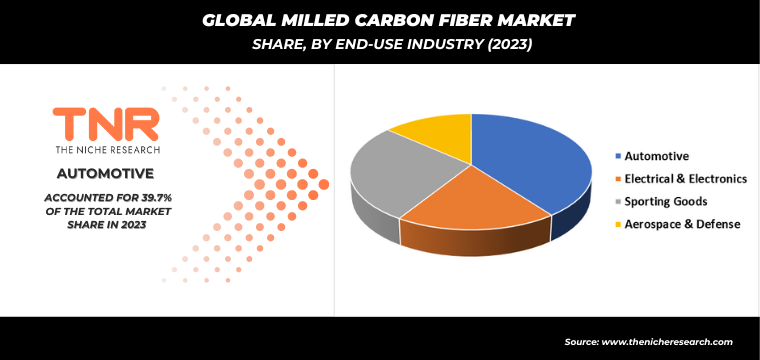
By Region, Europe Garnered Major Share in Global Milled Carbon Fiber Market in 2023.
Europe has garnered major share in the global carbon milled carbon fiber. The automotive sector, striving to meet stringent emissions regulations and enhance fuel efficiency, is increasingly adopting milled carbon fiber for lightweighting components, thereby reducing vehicle weight and improving performance. Additionally, the aerospace industry leverages the material’s high strength-to-weight ratio for producing lighter, more fuel-efficient aircraft components. The renewable energy sector, particularly wind energy, also contributes to demand, using milled carbon fiber to reinforce turbine blades for better durability and efficiency.
Furthermore, the growing emphasis on sustainable and advanced manufacturing techniques, including 3D printing and additive manufacturing, relies on milled carbon fiber to produce complex, high-performance parts with reduced environmental impact. These factors collectively drive the European market for milled carbon fiber, reflecting its essential role in achieving energy efficiency and sustainability goals across key industries. Additionally, the wind energy sector’s expansion, supported by the EU’s goal to increase wind power capacity to 450 GW by 2050, further boosts the demand for durable and efficient materials like milled carbon fiber.
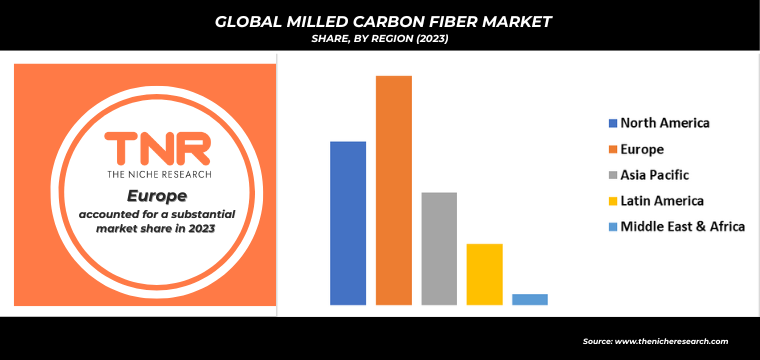
Competitive Landscape: Global Milled Carbon Fiber Market:
- CLMPro
- Daigas Group
- Easy Composites Ltd
- Haufler Composites GmbH & Co. KG
- Nantong Yongtong Environmental Technology Co., Ltd.
- Nippon Graphite Fiber Co., Ltd.
- Procotex
- R&G Faserverbundwerkstoffe GmbH
- SGL Carbon
- Stanford Advanced Materials
- Tasuns Composite Technology Co., Ltd.
- Other Industry Participants
Global Milled Carbon Fiber Market Scope
| Report Specifications | Details |
| Market Revenue in 2023 | US$ 192.5 Mn |
| Market Size Forecast by 2034 | US$ 560.3 Mn |
| Growth Rate (CAGR) | 10.2% |
| Historic Data | 2016 – 2022 |
| Base Year for Estimation | 2023 |
| Forecast Period | 2024 – 2034 |
| Report Inclusions | Market Size & Estimates, Market Dynamics, Competitive Scenario, Trends, Growth Factors, Market Determinants, Key Investment Segmentation, Product/Service/Solutions Benchmarking |
| Segments Covered | By Fiber Type, By Application, By End Use Industry, By Region |
| Regions Covered | North America, Europe, Asia Pacific, Middle East & Africa, Latin America |
| Countries Covered | U.S., Canada, Mexico, Rest of North America, France, The UK, Spain, Germany, Italy, Nordic Countries (Denmark, Finland, Iceland, Sweden, Norway), Benelux Union (Belgium, The Netherlands, Luxembourg), Rest of Europe, China, Japan, India, New Zealand, Australia, South Korea, Southeast Asia (Indonesia, Thailand, Malaysia, Singapore, Rest of Southeast Asia), Rest of Asia Pacific, Saudi Arabia, UAE, Egypt, Kuwait, South Africa, Rest of Middle East & Africa, Brazil, Argentina, Rest of Latin America |
| Key Players | CLMPro, Daigas Group, Easy Composites Ltd, Haufler Composites GmbH & Co. KG, Nantong Yongtong Environmental Technology Co., Ltd., Nippon Graphite Fiber Co., Ltd., Procotex, R&G Faserverbundwerkstoffe GmbH, SGL Carbon, Stanford Advanced Materials, Tasuns Composite Technology Co., Ltd. |
| Customization Scope | Customization allows for the inclusion/modification of content pertaining to geographical regions, countries, and specific market segments. |
| Pricing & Procurement Options | Explore purchase options tailored to your specific research requirements |
| Contact Details | Consult With Our Expert
Japan (Toll-Free): +81 663-386-8111 South Korea (Toll-Free): +82-808- 703-126 Saudi Arabia (Toll-Free): +966 800-850-1643 United Kingdom: +44 753-710-5080 United States: +1 302-232-5106 E-mail: askanexpert@thenicheresearch.com
|
Global Milled Carbon Fiber Market
By Fiber Type
- Virgin Fiber
- Recycled Fiber
By Application
- Reinforcements
- Coatings & Adhesives
- Others
By End-Use Industry
- Automotive
- Electrical & Electronics
- Sporting Goods
- Aerospace & Defense
By Region
- North America (U.S., Canada, Mexico, Rest of North America)
- Europe (France, The UK, Spain, Germany, Italy, Nordic Countries (Denmark, Finland, Iceland, Sweden, Norway), Benelux Union (Belgium, The Netherlands, Luxembourg), Rest of Europe)
- Asia Pacific (China, Japan, India, New Zealand, Australia, South Korea, Southeast Asia (Indonesia, Thailand, Malaysia, Singapore, Rest of Southeast Asia), Rest of Asia Pacific)
- Middle East & Africa (Saudi Arabia, UAE, Egypt, Kuwait, South Africa, Rest of Middle East & Africa)
- Latin America (Brazil, Argentina, Rest of Latin America)
Report Layout:
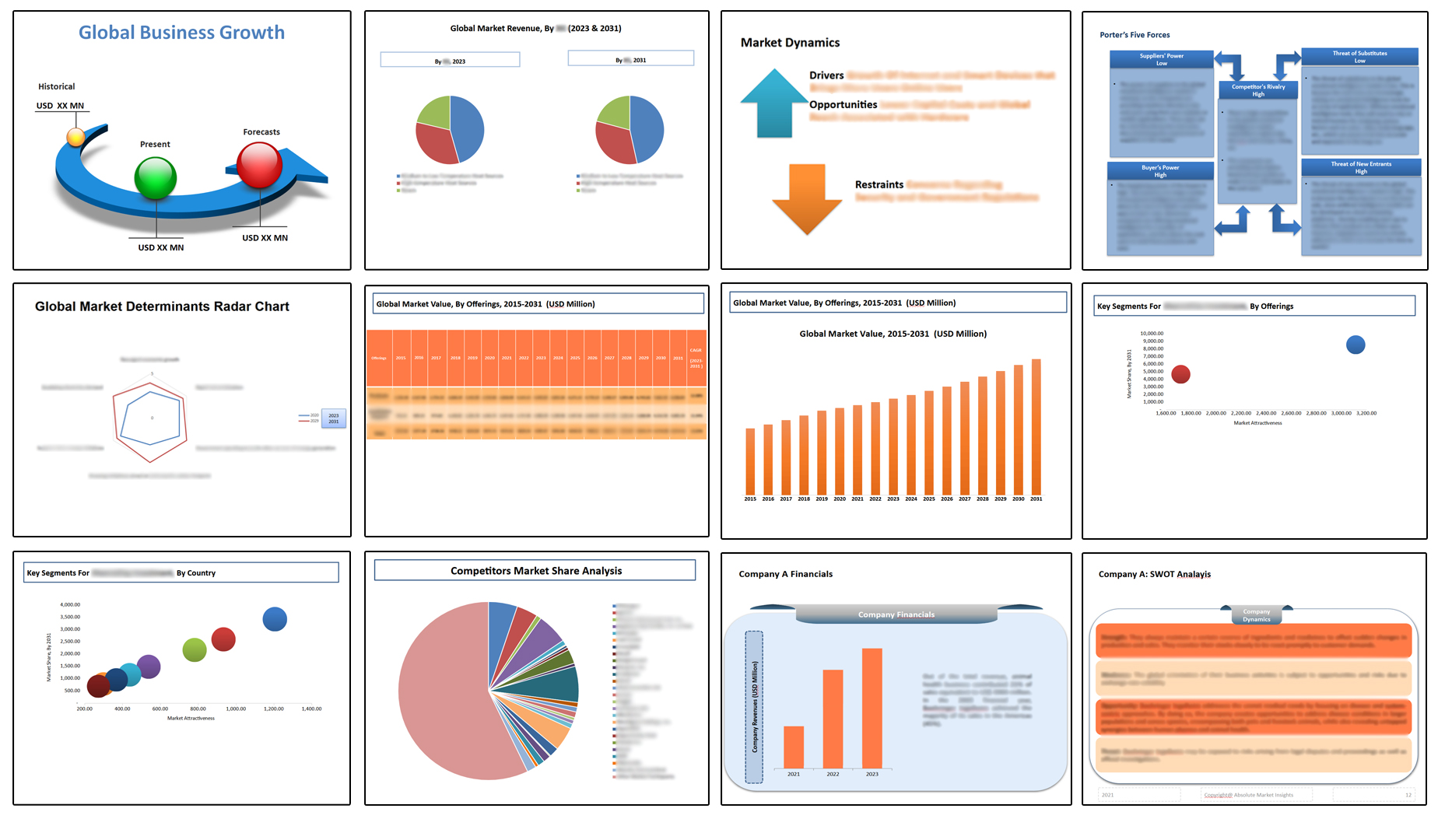
Table of Contents
Note: This ToC is tentative and can be changed according to the research study conducted during the course of report completion.
**Exclusive for Multi-User and Enterprise User.
Global Milled Carbon Fiber Market
By Fiber Type
- Virgin Fiber
- Recycled Fiber
By Application
- Reinforcements
- Coatings & Adhesives
- Others
By End-Use Industry
- Automotive
- Electrical & Electronics
- Sporting Goods
- Aerospace & Defense
By Region
- North America (U.S., Canada, Mexico, Rest of North America)
- Europe (France, The UK, Spain, Germany, Italy, Nordic Countries (Denmark, Finland, Iceland, Sweden, Norway), Benelux Union (Belgium, The Netherlands, Luxembourg), Rest of Europe)
- Asia Pacific (China, Japan, India, New Zealand, Australia, South Korea, Southeast Asia (Indonesia, Thailand, Malaysia, Singapore, Rest of Southeast Asia), Rest of Asia Pacific)
- Middle East & Africa (Saudi Arabia, UAE, Egypt, Kuwait, South Africa, Rest of Middle East & Africa)
- Latin America (Brazil, Argentina, Rest of Latin America)
The Niche Research approach encompasses both primary and secondary research methods to provide comprehensive insights. While primary research is the cornerstone of our studies, we also incorporate secondary research sources such as company annual reports, premium industry databases, press releases, industry journals, and white papers.
Within our primary research, we actively engage with various industry stakeholders, conducting paid interviews and surveys. Our meticulous analysis extends to every market participant in major countries, allowing us to thoroughly examine their portfolios, calculate market shares, and segment revenues.
Our data collection primarily focuses on individual countries within our research scope, enabling us to estimate regional market sizes. Typically, we employ a bottom-up approach, meticulously tracking trends in different countries. We analyze growth drivers, constraints, technological innovations, and opportunities for each country, ultimately arriving at regional figures.Our process begins by examining the growth prospects of each country. Building upon these insights, we project growth and trends for the entire region. Finally, we utilize our proprietary model to refine estimations and forecasts.
Our data validation standards are integral to ensuring the reliability and accuracy of our research findings. Here’s a breakdown of our data validation processes and the stakeholders we engage with during our primary research:
- Supply Side Analysis: We initiate a supply side analysis by directly contacting market participants, through telephonic interviews and questionnaires containing both open-ended and close-ended questions. We gather information on their portfolios, segment revenues, developments, and growth strategies.
- Demand Side Analysis: To gain insights into adoption trends and consumer preferences, we reach out to target customers and users (non-vendors). This information forms a vital part of the qualitative analysis section of our reports, covering market dynamics, adoption trends, consumer behavior, spending patterns, and other related aspects.
- Consultant Insights: We tap into the expertise of our partner consultants from around the world to obtain their unique viewpoints and perspectives. Their insights contribute to a well-rounded understanding of the markets under investigation.
- In-House Validation: To ensure data accuracy and reliability, we conduct cross-validation of data points and information through our in-house team of consultants and utilize advanced data modeling tools for thorough verification.
The forecasts we provide are based on a comprehensive assessment of various factors, including:
- Market Trends and Past Performance (Last Five Years): We accurately analyze market trends and performance data from preceding five years to identify historical patterns and understand the market’s evolution.
- Historical Performance and Growth of Market Participants: We assess the historical performance and growth trajectories of key market participants. This analysis provides insights into the competitive landscape and individual company strategies.
- Market Determinants Impact Analysis (Next Eight Years): We conduct a rigorous analysis of the factors that are projected to influence the market over the next eight years. This includes assessing both internal and external determinants that can shape market dynamics.
- Drivers and Challenges for the Forecast Period:Identify the factors expected to drive market growth during the forecast period, as well as the challenges that the industry may face. This analysis aids in deriving an accurate growth rate projection.
- New Acquisitions, Collaborations, or Partnerships: We keep a close watch on any new acquisitions, collaborations, or partnerships within the industry. These developments can have a significant impact on market dynamics and competitiveness.
- Macro and Micro Factors Analysis:A thorough examination of both macro-level factors (e.g., economic trends, regulatory changes) and micro-level factors (e.g., technological advancements, consumer preferences) that may influence the market during the forecast period.
- End-User Sentiment Analysis: To understand the market from the end-user perspective, we conduct sentiment analysis. This involves assessing the sentiment, preferences, and feedback of the end-users, which can provide valuable insights into market trends.
- Perspective of Primary Participants: Insights gathered directly from primary research participants play a crucial role in shaping our forecasts. Their perspectives and experiences provide valuable qualitative data.
- Year-on-Year Growth Trend: We utilize a year-on-year growth trend based on historical market growth and expected future trends. This helps in formulating our growth projections, aligning them with the market’s historical performance.
Research process adopted by TNR involves multiple stages, including data collection, validation, quality checks, and presentation. It’s crucial that the data and information we provide add value to your existing market understanding and expertise. We have also established partnerships with business consulting, research, and survey organizations across regions and globally to collaborate on regional analysis and data validation, ensuring the highest level of accuracy and reliability in our reports.


